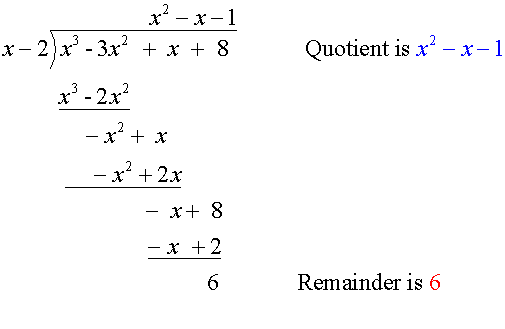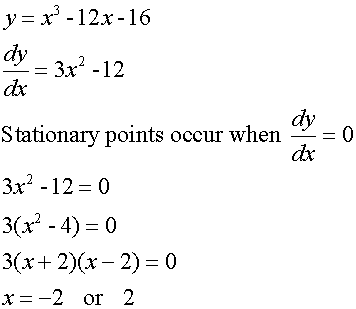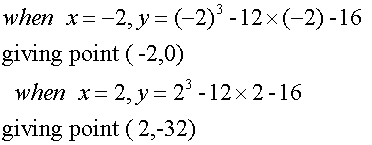Polynomials
A polynomial in x is an expression involving the algebraic sum of powers of x.
The degree of the polynomial is the highest power.
The coefficient of a term is the number in front of that term.
The value of a polynomial is found by replacing each letter in the
expression by a number.
Example
If f(x) = 2x3+3x2-7, find the value of the polynomial at x = -2
The value of f(-2) = 2(-2)3+3(-2)2-7
= 2 x (-8) + 3x4 -7
= -16 +12 -7
= - 11
Evaluating a polynomial in nested form
f(x) = ax3+ bx2 + cx + d
= (ax2+ bx + c)x + d
= ((ax + b) x +c)x + d
Compare with

Example
Evaluate f(-2) when f(x) = 2x3 + 3x2 + 5

f (-2) = 1
Division of Polynomials
Example
Divide x3- 3x2 + x + 8 by x-2


Synthetic Division
Example
Divide x3- 3x2 + x + 8 by x-2
- Write the co-efficients along the top.
- Write the negative of the divisor on the side.
- Carry the first number down.
- Multiply the bottom number by the side number,
- place in middle of next column,
- then add the top number of that column.
- When reading off,the degree of the co-efficient is one less than the original.

Divisor is x-2
Coefficients of Quotient is x2-x-1
Remainder = 6
so x3- 3x2 + x + 8 = (x - 2)(x2- x - 1) + 6
Example
Divide 3x3- 7x2 + 5x + 4 by x + 3

so
3x3- 7x2 + 5x + 4 = (x +3)(3x2 - 16x + 53) -155
And f ( -3) = -155
Division by ax + b
Example
Find the quotient and remainder when 4t3+ 6t2 – 2t -1
is divided by 2t + 1
2t + 1 =2( t + ½)
Use synthetic division for (t + ½)

so 4t3+ 6t2 – 2t -1 =(t + ½)(4t2 + 4t -4) + 1
to return to the original divisor, 2t + 1,
double (t + ½) and half the quotient.
4t3+ 6t2 – 2t -1 =2(t + ½)x½ (4t2 + 4t -4) + 1
4t3+ 6t2 – 2t -1 =(2t + 1)(2t2+ 2t -2) + 1
Quotient is (2t2 + 2t -2) , remainder is 1.
The Remainder and Factor Theorems
The Remainder Theorem
If a polynomial f(x) is divided by x-h, then the remainder is f(h).
( h may be a fraction)
The Factor Theorem
If f(x) is a polynomial , f(h) = 0<=> (x-h) is a factor of f(x)
Example
Fully factorise 2t3 - 5t2 + 4t - 21
Since the constant is 21, try the numbers for h as
±1, ±3, ±7, ±21 ( Use a pencil!)

So 2t3 - 5t2 + 4t - 21= (t-3)(2t2 + t + 7)
Solving Polynomial Equations
If the polynomial is of degree 3 or higher, factorise using synthetic division.
Ensure f(x) = 0 before factorising.
Example
Solve the equation x4 - 5x2+ 4 = 0
Either:

go again

or combine

x4 - 5x2 + 4 = 0
(x - 1)(x3 + x2 - 4x - 4) = 0
(x - 1)(x + 1)( x2 – 4 )=0
(x - 1)( x + 1)( x - 2)(x + 2)=0
So x = 1, -1, 2 or -2 ( These are the roots of the equation)
Example
Given that x + 2 is a factor of 2x3 + x2 + kx + 2,
find the value of k.

Since x + 2 is a factor, we know that the remainder is zero.

If the polynomial equation does not factorise, use an iterative method to solve the equation approximately.
Example
Show that x3-4x+2 = 0 has a root between 0.5 and 1
and find an approximation correct to 1 decimal place.
f ( x) = x3- 4x+2
f (0.5) = (0.5)3 – 4 x 0.5 + 2
= 0.125 - 2 + 2
= 0.125
f (1) = 1 - 4 + 2
= -1
Since f (0.5) > 0 and f (1) < 0, there is a root f (x) = 0
Between 0.5 and 1
f (0.7) = 0.343 -2.8 +2 = -0.457
f (0.6) = 0.216- 2.4 +2 = -0.184
So root f(x) lies between 0.5 and 0.6
f (0.55) = 0.66375 - 2.2 +2 = -0.034
Since root lies between 0.5 and 0.55, root is 0.5 correct to 1 decimal place.
Sketching the graphs of polynomials.
To sketch the graph of a polynomial,
- Identify the y-intercept
- Identify the x – intercept
- Find stationary points
- Identify nature of stationary points
- Investigate what happens as values approach infinity
Example
Sketch and fully annotate the graph of y = x3 – 12x -16
- Identify the y-intercept
The graph cuts the y axis when x = 0
y = 03 – 12x0 -16
y = -16
point (0,-16) is on the graph
- Identify the x – intercept
The graph cuts the x axis when y = 0.
This occurs at the roots of the equation, so use synthetic division.

x3 – 12x -16 = 0
(x - 4)(x2 +4x + 4) = 0
(x - 4)(x + 2) (x + 2)=0
So x = 4 or -2
points (4,0) and (-2,0) are on the graph
Find stationary points


- Identify nature of stationary points

- Draw graph

